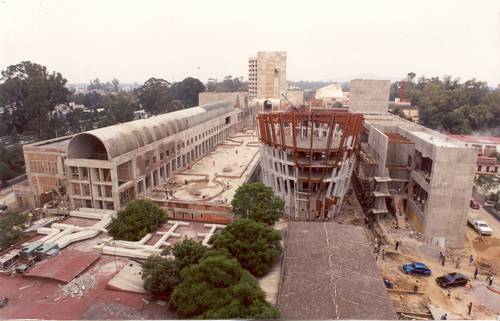Upon crossing the doors of the National Center for the Arts (Cenart), the visitor is welcomed by an emotional and inspiring atmosphere, in which creativity, memory and innovation are intertwined. This distinctive space, which today celebrates three decades of existence, has established itself as a cultural and educational reference not only in Mexico, but in Latin America.
In its almost 12 hectares, the site is much more than a conglomerate of buildings: it is a vibrant mosaic of ingenuity that includes schools, research centers, theaters, auditoriums and outdoor spaces that coexist in perfect harmony.
Each corner tells a story that highlights its educational and artistic vocation. Its infrastructure and the number of academic exchanges with more than 30 countries place it as a cultural hub with global reach.
This Sunday the 24th, starting at 6:30 p.m., the Great Anniversary Pachangón will be held in the green areas of Cenart (Río Churubusco and Tlalpan road), with the participation of the Perla Antillana sound and free admission.
Since its foundation in 1994, promoted by the then National Council for Culture and the Arts, under the direction of Rafael Tovar and Teresa, and with an approximate investment of 260 million of what was then called new weights
Cenart took on an ambitious challenge: to create an educational model that would train artists in their specific disciplines, in addition to promoting a constant dialogue between the arts and new technologies.
This approach distinguishes it as a space in which innovative ideas and trend-setting artistic projects are cultivated.
The Cenart architectural complex is distinguished by the vision of prominent contemporary Mexican architects.
The master design of Ricardo Legorreta, accompanied by the collaboration of figures such as Enrique Norten and Teodoro González de León, gives life to a space that combines functionality with beauty. Every element, from the sloping walls of the Blas Galindo auditorium to the tiled façade of the José Vasconcelos auditorium, designed by Vicente Rojo, is a work of art.
At its core, five professional schools converge that cover disciplines as diverse as classical dance, theater, music, plastic arts and cinema.
In turn, research centers promote the study and conservation of artistic expressions from different approaches and perspectives.
Majestic settings
The Raúl Flores Canelo and Salvador Novo theaters, with capacity for 336 and 150 spectators, respectively, offer unique experiences that range from classic presentations to experimental works. For its part, the Arts Forum and the type spaces black box
like the Antonio López Mancera and the Black Box, stand out for their versatility for interdisciplinary projects. The open-air Plaza de las Artes becomes a majestic stage for more than 1,500 attendees, while the Blas Galindo auditorium stands out with its acoustics and impressive design.
On August 15, 2023, Cenart marked a new milestone with the inauguration of the Cineteca de las Artes, a space that celebrates Mexican cinema and strengthens its cultural offer.
On the other hand, its educational approach goes beyond the traditional classroom. The commemorative book National Center for the Arts 1994-2004 highlights that The constant interaction with active artists, the incorporation of new technologies and the direct link with professional life allow students to be trained as complete creators, prepared for the challenges of the contemporary art world. This model encourages experimentation, interdisciplinarity and the use of innovative tools as essential elements of the training process.
.
Likewise, it has managed to bring together a diverse community made up of students, teachers, researchers, workers and visitors, who find in this space a continuous source of inspiration and learning. International collaborations, academic exchanges and activities open to the public reinforce its role as a bridge between cultures, disciplines and generations.
Research, for its part, is fundamental for Cenart’s educational model, since It is not limited to analysis or documentation techniques; focuses on the construction of concepts and the exploration of artistic problems that drive creation and critical analysis. This comprehensive approach reinforces the connection between theory and practice, enriching the educational offer
adds the publication.
On its 30th anniversary, Cenart remains as living space that honors your legacy while looking to the future
. From its first director, Álvaro Rodríguez Tirado, to the current one, Antonio Zúñiga Chaparro, each management has left a particular mark on the development of this cultural complex.
The combination of its emblematic architecture, its avant-garde educational approach and its commitment to artistic dissemination make it a meeting point for those who value and enjoy art in all its forms.
30 years after its foundation, Cenart also faces important challenges and pending issues. Problems such as the lack of infrastructure maintenance or the precarious salaries for teachers and administrative staff have generated unrest in the artistic community.
According to teachers and students, these problems reveal the urgent need to strengthen institutional and budgetary support to ensure that Cenart remains one of the most important cultural centers in the country
.
